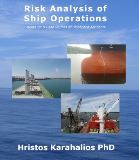Emergency Helicopter Operations
Helicopter operations may be required for routine operations such as pilot or crew transfer. However, there are also emergency conditions such as evacuation of a ship or medical assistance provided to a crewmember or passenger. For all these cases, the SMS should include procedures for landing site designation and crew training. Both are SOLAS 74 requirements detailed in regulation II-2/18.2.2 where the appropriate definitions are provided.
See Training Video of Ship Evacuation With Spanish SAR
A ship may be requested to receive a pilot by helicopter although not designated landing or winch area is designated onboard. In this case, the ship’s master should ensure that there is a space on a ship with at least twice the main rotor diameter to avoid any obstacles. The pilot and ship’s master should communicate at all times efficiently, and both are in good agreement with safety concerns. It should also be reminded that the helicopter pilot will have to comply with flight rules as the layout in Civil Aviation Regulations who may not be aware of any IMO or similar standards. Ship’s crew should be trained for any shipboard operation they have to perform. An officer should be in charge of a party assisting helicopter landing party. The risk involved is a collision between helicopter and ship. Therefore, firefighting and rescue plan should be enforced.
Shipboard communication with rescue centres and company could determine the efficiency of a contingency plan. However, depending on the geographical area that a ship in distress is the reaction from the nearby coast may not be sufficient. For instance, in the case of Erika disaster seafarers were saved by British helicopters due to lack of appropriate equipment from French authorities.
With respect to landing areas, these depend on the structural condition of the ship and available spaces. A ship should hold a class attestation that a designated area is allowed for helicopter landing. For routine operations, any area may be agreed between the pilot and ship’s master. A helicopter in order to land needs a particular area which should be marked on the ship’s deck or a hatch cover. AMSA recommends that the landing site or winching area should be laid out for D = 20 meters. Helicopter landing sites consist of 3 zones which should be clearly marked as follows (AMSA 2016) :
a) Touchdown zone, Centre marked by white or yellow capital H measuring 0.2D x 0.1D formed of lines 0.02D wide.
b) Clear zone, which is the area required for safe rotation of the rotor blades. The clear zone shall be D in diameter.
c) Manoeuvring zone, which is the extra allowed are for manoeuvring. Outer limit marked by hatched white or yellow line at least 20 cm wide.
In a case, a winching area is located then AMSA recommends that this should be laid out for D equal to 20 meters (or minimum 12 meters). The phrase “WINCH ONLY” should be clearly marked to be visible for pilots. A typical marking scheme should consist of the phrase above marked in white or yellow capital letters with dimensions 0.2D. In a winching area, a helicopter can operate in low altitude to transfer personnel or stores, an operation which is called over.
Helicopter Operations (Case Study)
The use of a helicopter in an emergency may be crucial for the rescue of a seafarer. The ship’s master should be aware that immediate contact with coastal authorities demonstrates responsibility regarding the safety of the crew. On 2 November 2014, a fishing vessel was foundered 100 miles north-east of Tynemouth. The casualty has, as a result, the of three fatalities. In the investigation report the authorities made the following comment (MAIB Report No 23/2015):
“It is important that procedures are followed to avoid essential information being overlooked when staff is engaged in demanding situations. The opportunity to appoint a rescue helicopter at an earlier stage of the incident was missed.”

